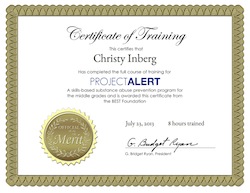
Dear Educators:
We have important news to share about Project ALERT that may come as a surprise.
In 2015 we will celebrate the thirtieth anniversary of this wonderful program and after much deliberation, it is our consensus here at the BEST Foundation that it’s time to phase out our work in prevention education.
Nothing will change during this academic year. Then, beginning with the 2014-2015 academic year, Project ALERT will be web-based only. Online teacher training and certification will remain intact and you will be able to download all classroom materials and the videos for free as long as you wish, although we will not be updating them.
We will be available for phone support through the end of the 2013-2014 academic year and will continue to offer support through our website for the foreseeable future. Be assured that Project ALERT will maintain its position on the federal government’s National Registry of Evidence-based Programs and Practices.
Project ALERT has held a rarified place in the field of prevention education for 30 years, pioneering a behavioral modification approach to teaching resistance skills to young people. As our changing society creates new challenges for prevention educators, we feel confident that the solid foundation of knowledge and strategies that we have developed will help guide other resistance programs.
We feel both gratitude and satisfaction when we look back on what we’ve accomplished, including the wonderful partnership we’ve enjoyed with all of you—the dedicated trainers, safe and drug-free school coordinators, counselors, teachers, nurses, community coalitions, and all who have been part of the movement to evidence-based programs. Together we have made a difference in the lives of young people.
Our program came into existence through the generosity of the Conrad N. Hilton Foundation, which has awarded grants in excess of $65 million to the RAND Corporation and the BEST Foundation—the two organizations responsible for the development and dissemination of Project ALERT. Before his death in 1979, Conrad Hilton directed that his foundation work to “relieve the suffering, the distressed, and the destitute.” In 1981, Don Hubbs, then the new president of the Hilton Foundation, brought to the Foundation’s Board of Directors a long list of social problems that would have interested Hilton. It included drug abuse, then a growing problem in America, though not yet on the national radar.
Members of the board were immediately interested: nearly all of them knew someone adversely affected by alcohol, cigarettes, and/or substance abuse. They conceded that any attempt to address this problem would be expensive, and would take considerable time.
Hubbs turned for help to the renowned RAND Corporation, a California-based think tank whose mission was to find solutions to problems. Supported by grants from the Hilton Foundation, a team of RAND researchers, headed by behavioral scientist Phyllis Ellickson, PhD, began working on the challenge of finding the most effective way to impact drug usage. After long study, they concluded that prevention was the most promising - and that it should begin in middle school.
By 1984, Ellickson and her team were conducting field testing with students in their search for the best form of prevention education. They knew that it had to impact both internal and external pressures, giving special consideration to the impact of peer pressure. Testing took five years. Steve Hilton, current president of the Hilton Foundation, has noted that only a handful of school-based prevention programs have gone through this same rigorous testing.
In addition to appealing print materials, research proved that the most effective teaching tools included classroom discussion, small group activities, role-playing, videos, and homework assignments that involved parents, so all of these became part of the curriculum of the program, now named Project ALERT, with ALERT standing for Adolescent Learning Experiences in Resistance Training.
At the time, drug resistance programs relied almost exclusively on instructors delivering information to students and expecting them to do as they were told. In contrast, we trained teachers in how to deliver Project ALERT using an interactive learning model. This teacher training became a key component of the program.
The next step was dissemination. In 1990 the Hilton Foundation established the BEST Foundation for a Drug-Free Tomorrow to provide information, materials, guidance and teacher training. Trainers conducted training sessions for classroom teachers all over the nation. In keeping with its name—BEST stands for Bringing Everyone’s Strengths Together—the staff at the BEST Foundation was readily available to answer questions and trouble shoot issues that might arise.
Once launched, Project ALERT was immediately embraced by prevention experts and the program grew rapidly. By 2004 it was reaching over a million adolescents every year. To keep it as up to date as possible, materials and videos have been updated several times to incorporate new usage trends and research. We have learned, for example, that Project ALERT works equally well in schools with low and high minority populations and in both urban and rural settings. While we anticipated that Project ALERT would help low risk youth stay away from drugs, it also helps high risk kids avoid increased drug use. This in turn curbs risky behaviors that can harm the health and future of young people. Not only that, its impact lasts into young adulthood and positively impacts other risky behaviors, including sexual practices linked with HIV and unwanted pregnancy.
Through the years, we’ve enjoyed some significant highpoints, including these:
*In 1994 Nancy Reagan joined the board of the BEST Foundation and is currently a Director Emeritus.
*In 1996 Making the Grade - the first US guide to school prevention programs -gave Project ALERT straight A’s.
*In 1999 the Substance Abuse and Mental Health Services Administration’s Center for Substance Abuse Prevention designated Project ALERT as an Exemplary Program—an honor we also received in 2001 from the US Department of Education.
*In 2007 Project ALERT was placed on the National Registry of Evidence-based Programs and Practices.
*By 2009 we had trained 50,000 teachers, many of them online through our self-guided program.
*In 2011 Project ALERT was being used by 4,000 schools and 21,000 middle grade teachers. That year it became entirely web-based, allowing users to have immediate access to program materials and archives.
Nearly a decade ago, Don Hubbs summarized the overall impact of Project ALERT when he commented, “If you can keep children off the gateway drugs, then the odds are much better that they’ll stay off hard drugs later on. And if you can keep them off drugs until they are 21, they are almost certain to be drug-free from then on. One key is to teach them how to resist drugs in various social situations. Another is to help them realize for themselves why they shouldn’t use drugs. Our program succeeds in doing that.”
As if looking into a crystal ball, he then added, “We know Project ALERT is the best program of its type currently available. Any new drug education programs will be based on our principles of research. . . . We just want progress. We’re not looking for permanence.”
We feel fortunate that we’ve been able to create something so meaningful, and that we’ve had the privilege of partnering with all of you in our efforts to help young people reach adulthood with the best resistance skills possible. We’ve met many of you and celebrated your stories over the years in our print and online newsletters, and we are going to miss working with you. We’re counting on you to continue your commitment to helping the youth of our nation by educating them about drug prevention.
With all good wishes,
![]()
G. Bridget Ryan
President
*On September 4, 2013 this letter was sent to ALERT educators. We are providing the letter in electronic format to facilitate saving and sharing.



